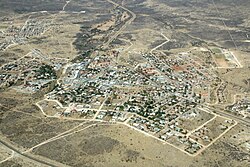Outjo
Outjo
Khoekhoe: Tsūob | |
|---|---|
City | |
 Aerial view of Outjo (2018) | |
| Coordinates: 20°06′32″S 16°09′17″E / 20.10889°S 16.15472°E | |
| Country | |
| Region | Kunene Region |
| Constituency | Outjo Constituency |
| Government | |
| • Mayor | I. Katambo [1] |
| Area | |
• Total | 97.9 km2 (37.8 sq mi) |
| Population | |
• Total | 15,063 |
| Time zone | UTC+2 (SAST) |
| Climate | BSh |
Outjo (Otjiherero: small hills) is a town[4] of 15,000 inhabitants in the Kunene Region of Namibia. It is the district capital of Outjo Constituency. It is best known as the main gateway to Etosha National Park.[5]
Overview
[edit]The town was founded by Germans under the command of Colonel Theodor von Leutwein in 1897 as a small military base in order to explore the northern area of German South West Africa. The local historical museum (Franke Haus Museum) details the campaign of Major Viktor Franke in Ovamboland.
The "Naulila monument" commemorates the small expedition on the Portuguese fort of Naulila in Angola by Major Viktor Franke in October 1914 following the massacre of a German delegation which had been sent to negotiate a treaty of non-aggression. It is one of the fastest developing towns in the Kunene Region.
South of Outjo is the Ugab River, one of the major rivers of Namibia.[6] The town lies near Gamkarab Cave, known for its stalactites and stalagmites and its pietersite. The caves are on private ground and not open to the public.
Politics
[edit]Outjo is governed by a municipal council that has seven seats.[7]
Since the independence of the country, Outjo is the only small town in the Kunene Region controlled by the ruling party "SWAPO". The 2015 local authority election was won by SWAPO which gained four seats (1,307 votes). Two seats went to the United Democratic Front (UDF, 706 votes), and the remaining seat was won by the Democratic Turnhalle Alliance (DTA) with 381 votes.[8] SWAPO also won the 2020 local authority election but lost majority control over the municipal council. It obtained 872 votes and three seats. One seat each went to the Landless People's Movement (LPM, a new party registered in 2018, 501 votes), the UDF (392 votes), the Popular Democratic Movement (PDM, the new name of the DTA, 307 votes), and the Monitor Action Group (MAG, 161 votes).[9]
Transport
[edit]Situated on the C38 - 90 kilometres (56 mi) southwest of the Anderson Gate - Outjo is the gateway to the Etosha National Park. Damaraland can be reached by travelling through Outjo on the C39 to Khorixas and the C40 towards Kamanjab leads to the Kaokoveld.
Outjo has an airstrip about 10 kilometres (6.2 mi) out of town that can accommodate small fixed-winged planes. Outjo is the terminus of a branch railway of the Namibian railway system, but there is no railway service at the moment[update].
Schools
[edit]Within the town limits of Outjo are three primary schools and two secondary schools as well as a combined private school.
- Jack Francis Primary School
- Maarssen Primary School
- Outjo Primary School
- Moria Private School
- Etoshapoort Junior Secondary School
- Outjo Secondary School
The following schools are located in the vicinity of the town:
- Otjikondo School Village & Primary School (about 85 kilometers northwest of the city)
- St. Michael Roman-Catholic Primary School (about 70 kilometers northwest of the city)
Tourist attractions
[edit]

Outjo offers some sights, but it is above all an important tourist transit and supply point. In 2006, more than 22,000 tourists were counted per month.[10]Attractions in and around Outjo include:
- Franke-Haus-Museum
- Naulila monument
- The Water Tower Outjo, which was originally equipped with a wooden wind turbine and used for water extraction.
- Vingerklip (its mostly used Afrikaans name) - a fingerlike rock formation created through erosion
- The Ugab Terraces
- The Petrified Forest
- Twyfelfontein
- The Burnt Mountain
References
[edit]- ^ "Outjo Municipality". Archived from the original on 2013-06-23. Retrieved 2016-08-24.
- ^ "Table 4.2.2 Urban population by Census years (2001 and 2011)" (PDF). Namibia 2011 - Population and Housing Census Main Report. Namibia Statistics Agency. p. 39. Retrieved 24 August 2016.
- ^ "2023 Population & Housing Census Preliminary Report" (PDF). Statistics Namibia.
- ^ "Local Authorities". Association of Local Authorities in Namibia (ALAN). Archived from the original on 10 June 2013. Retrieved 1 October 2012.
- ^ "Outjo - town in Namibia". namibweb.com. Retrieved 27 September 2011.
- ^ Jacobson, Peter J.; Jacobson, Kathryn M.; Seely, Mary K. (1995). Ephemeral rivers and their catchments: Sustaining people and development in western Namibia (PDF 8.7MB). Windhoek: Desert Research Foundation of Namibia. pp. 134–135. ISBN 9991670947.
- ^ "Know Your Local Authority". Election Watch. No. 3. Institute for Public Policy Research. 2015. p. 4.
- ^ "Local elections results". Electoral Commission of Namibia. 28 November 2015. p. 5. Archived from the original on 10 December 2015.
- ^ "2020 Local Authority Elections Results and Allocation of Seats" (PDF). Electoral Commission of Namibia. 29 November 2020. p. 10. Archived from the original (PDF) on 24 January 2021. Retrieved 26 January 2021.
- ^ "Outjo Municipality - Tourism". www.outjomun.com.na. Retrieved 2024-11-11.


